

When you play Men of War it is easy to go for the most expensive or cheapest units and sacrifice them in a mindless assault, just like in that scene from Enemy at the Gates. It takes a bit of thought and experience to use your troops properly. Knowledge of your troops is one thing, but understanding the game mechanics and terrain is crucial to succeed. In this part of the Men of War Guide we will talk briefly about the Game Mechanics.
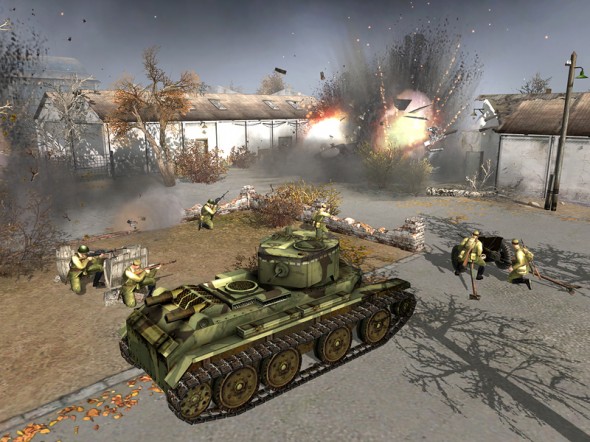
An explosion is as dangerous as it is impressive.
You can check the list of this Guide’s parts here.
Men of War mixes a number of highly demanding ideas which make it one of the most demanding RTS games I ever played. Terrain plays a heavy role in protecting your tank and infantry, but terrain and building can serve as a way of forcing the enemy out of hiding. Let us begin by talking briefly about Infantry.
Whether Soviet, Axis, US, Japanese or Commonwealth, Infantry is a very “Soft” target. Only the toughest Assault Troops have any real protection from light firearms, while all the other soldiers will have only their shirts and helmets. There are three types of ammo (and thus, weapons) that Infantry uses. Submachine gun, Rifle and “HMG” rounds. Depending on which weapon a soldier holds he will need an adequate supply of relevant ammo in order to use it. There is no real difference between the effectiveness of any ammo type, and it is usually the weapon itself that is most important.
Certain infantry types will be more skilled in using specific weapons. As such, Infantrymen using STG 44s will cope much worse than qualified Assault Troops. Aside from their firearms Infantry will also have other equipment at their disposal. Grenades will be most commonly used to attack or counter-attack enemy infantry and tanks. Grenades have a limited throwing range, often forcing you to hide your squads untill the last moment.
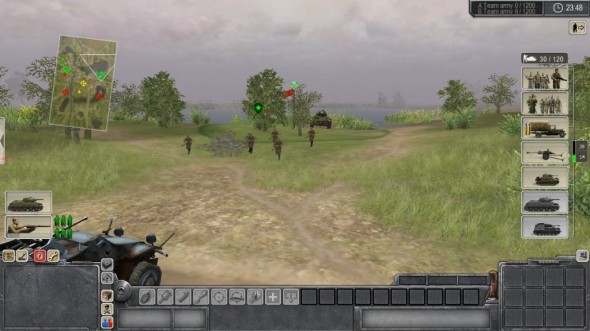
Infantry advancing forward with a T-34 behind. If not for that T-34 these riflemen would had been butchered by the Axis Armored Car.
One of the key ways for your Infantry to survive is using cover. Cover is divided into two types, what I call “Solid” and “Soft” cover. Solid cover is usually boulders, rocks and mountains, terrain which cannot be destroyed, and will safely protect anything on the other side. Soft Cover includes buildings, sandbags and trenches, locations which will provide adequate cover, but can be destroyed with the use of explosives or vehicles. Then there is “Camo”, which most commonly is formed by the different plants you find on the battlefield. Brushes and grass will hide your infantry, but they do not provide any cover.
Infantry can stand, crouch and go prone. The lower they are, the more hidden they are, as such being harder to hit, but also their accuracy increases. In the prone position soldiers can crawl making them very difficult to spot. A word of caution when moving in dense foliage. Bushes will move and cause noise as infantry or tanks move through them. The enemy will know where your infantry is without having to spot them.
Lastly, infantry can use Med-Kits to recover from wounds. Depending on the total hp loss, it might take as little as one kit or as many as three. Soldiers have to crouch in order to heal, and if they have not been in contact with the enemy for some time they will attempt to automatically heal themselves. If under attack by artillery infantry will also go prone, but usually not seek proper cover.
Tank Crews are qualified to use all and any types of vehicles and gun. Ordinary soldiers can only use lighter vehicles and heavier guns. Soldiers who lose their weapons due to an explosion will attempt to recover them, but you can find new weapons for them, as well as gather supplies from adequate crates or downed enemy/friendly troops.
Tanks, Vehicles and Guns/Emplacements need a “Crew” in order to operate fully. All of these will also have armour values, which influences how easily they can be damaged or destroyed by enemy fire. A transport truck will have minimal armour, making it vulnerable to small firearms, however a half-track is resistant to small firearms. Stationary guns, mainly Anti-Tank guns, but also Artillery guns, will have some armour plating at their front, protecting their crew and gun. Although small firearms will not penetrate them, most HE (high-explosive) and AP (Armour-piercing) rounds will not have much of a problem. Tanks and some Tank Destroyers will have the toughest plating, usually at the front, their flanks and rear being much weaker. This also applies to their turrets, and often a well positioned tank could be knocked out of action by an accurate turret shot.
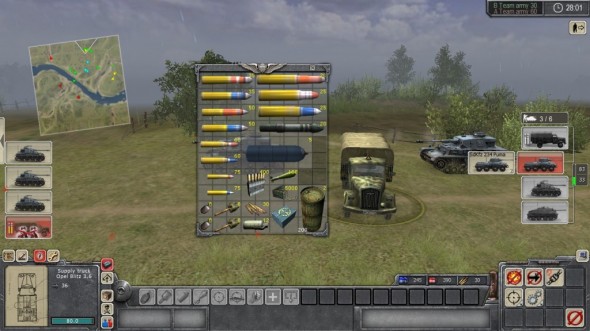
Your supply truck carries plenty of ammo for your tanks and guns. You just have to know which shells are for which.
Tanks and vehicles will use up fuel as they move. Although most vehicles do not survive long enough for this to happen they could run out of fuel. Fuel can be recovered from knocked out vehicles, but supply trucks will also hold a small supply. ammunition will also get used up, and you have to check what gun is present on a tank, so that the wrong ammo type is not given. All Tanks, Vehicles and Guns will have a Repair kit in their inventory. This will not get used up when used for repairs. Depending on the size of the tank repairs could last less than a minute, or for a much longer time, also depending on the extent of the damage.
Depending on the type of damage that a vehicle or gun suffers, you will be penalised in a certain way. Here is a brief list of possible types of damage that you could suffer:
Fire is one of the tank’s greatest foes, as it does not have to pierce any plating. A well placed molotov or burning brush or building could set the engine on fire or detonate the ammo storage. Sometimes an artillery explosion will cause a fire. A tank which is toppled on its side or top could also have an engine fire.
High-Explosive shells are perfect for destroying defences, killing infantry and destroying lighter vehicles. Against other tanks they will at best de-track them. AP shells aim at destroying anything armored. As such, against defenses and infantry they are ineffective. In order to penetrate an enemy tank you have to take into account the following “variables”:
Terrain influences angling more than some understand. Holding a higher position gives you a clear advantage under most circumstances. When aiming at a tank from above you will have an easier time penetrating its top plating. On the other hand, positioning your tank on higher ground makes it much more exposed to enemy flank fire.
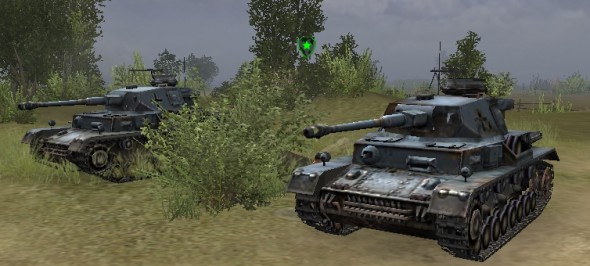
With a bit of experience you will recognise damage to a tank just by looking at it. For example, the Panzer IV on the right has a damaged turret.
Guns and Emplacements always have Camo and sandbags in their inventory, which allows them to set up a quick ambushing position. Most of the time however, the sandbags will only survive a few direct hits before becoming useless. Often, due to the size of the gun the sandbags will not protect it well. In order to guarantee a gun’s survival you must reposition it after ever few shots.
Guns can be towed by trucks and lighter vehicles. Use that advantage to quickly move squads of men together with an anti-tank gun. Mortars and HMGs cannot be quickly moved this way, and on bigger maps their role is often “outdated” once they reach the front.
Terrain can provide cover and camo to your men and vehicles. The colours on a vehicle do not appear to influence how easily it is spotted. Water is one of the more common terrain types you will find. If it is too deep infantry will be forced to swim through a river or pond. Tanks can traverse most water obstacles without any problem, although they are highly exposed during such a crossing attempt. Any HE shells will be much less effective against targets in water. It is a much better idea to target the ground on either side of the water crossing.
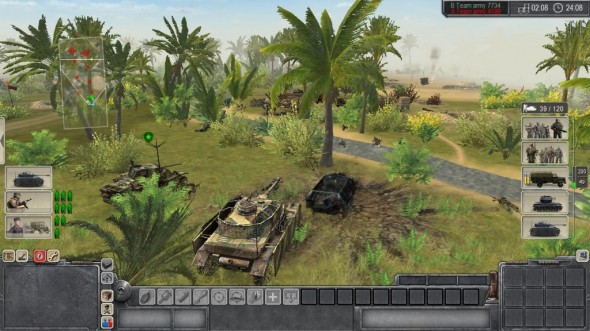
Jungle maps have plenty of shrubs for hostile infantry to hide in.
On winter maps you will find that most water crossings are frozen. These can be shattered with enough firepower, creating a deadly trap for both infantry and vehicles.
Most buildings can be destroyed if enough HE shells are fired. These pose a threat for infantry hidden within the building, because even if the explosion does not kill them, the falling rubble might.
Men of War is a demanding game for somebody who was never used to a bit more realism. Just like in Empire: Total War you have to sometimes check if your tank is safe or not by zooming in and tilting your camera to view the situation from the infantry man’s perspective. Only because your tank is hidden behind a hill does not mean its turret is not sticking out. Just as well, ignoring plenty of brushes could result in an ambush. It takes time to learn the full extent of the game mechanics in Men of War. Once you do learn them you might find a lot of other games mildly disappointing.
In the next part of this Guide we will look at what I call “Basic Deployment” and we will talk about some assault and defense ideas which you could use. Untill next time.

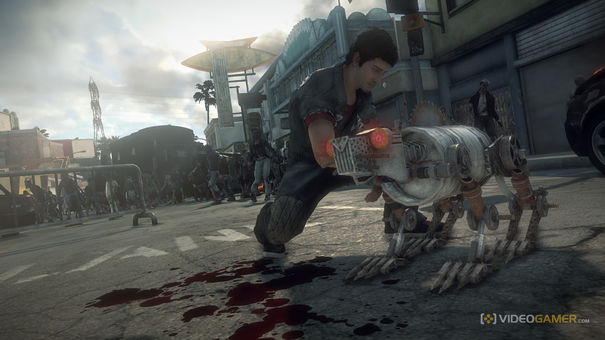


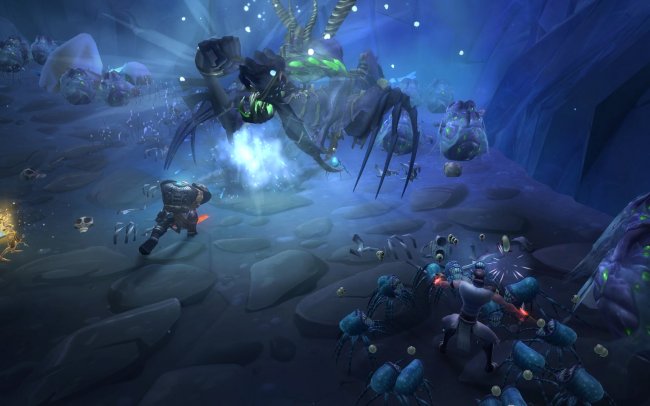 Wildstar: Dodging the WoW Factor
Wildstar: Dodging the WoW Factor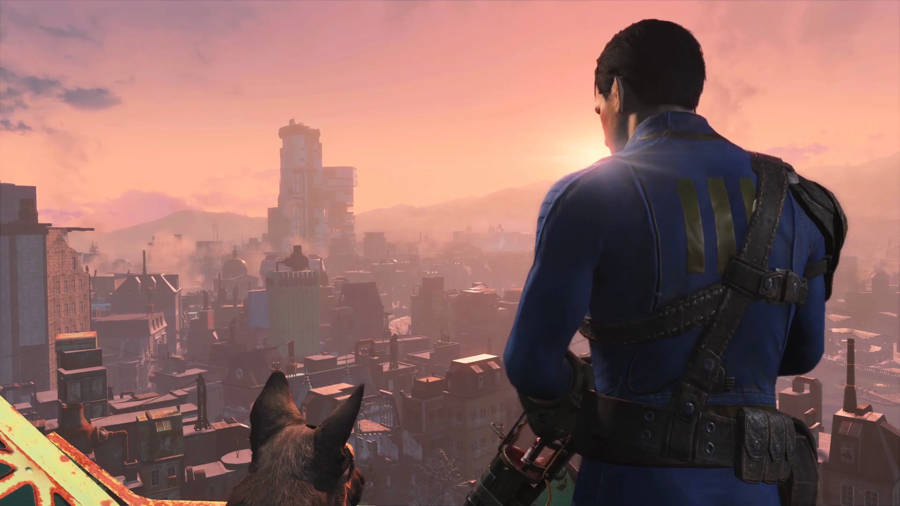 Fallout 4 Guide - Where To Find Infinite Amounts Of Copper For Your Settlement
Fallout 4 Guide - Where To Find Infinite Amounts Of Copper For Your Settlement Minecraft: Story mode to buy or not to buy
Minecraft: Story mode to buy or not to buy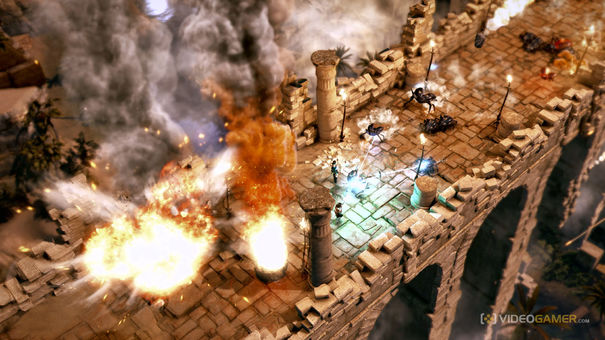 . Plays June 20, 2014
. Plays June 20, 2014 Walkthrough Grand Ages: Medieval
Walkthrough Grand Ages: Medieval